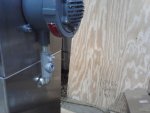petersonra
Senior Member
- Location
- Northern illinois
- Occupation
- Semi-retired engineer
I have a type 4 cabinet with an XP horn mounted on the outside.
the CL of the threaded opening for a 3/4 fitting on the bottom of the horn is no more than an inch from the wall of the box.
there will be a seal on the bottom of the horn, and then it has to turn into the box and enter through a hub of some sort.
is there some combination of fittings that I can do this with that will allow me to mount the horn flush to the side of the box? or will it need to be spaced away from the side of the box?
the CL of the threaded opening for a 3/4 fitting on the bottom of the horn is no more than an inch from the wall of the box.
there will be a seal on the bottom of the horn, and then it has to turn into the box and enter through a hub of some sort.
is there some combination of fittings that I can do this with that will allow me to mount the horn flush to the side of the box? or will it need to be spaced away from the side of the box?



